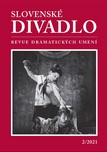UMELECKÉ A ESTETICKÉ VÝCHODISKÁ FILMU JÁNOŠÍK (1921)
THE ARTISTIC AND AESTHETIC POINTS OF DEPARTURE FOR THE FILM JÁNOŠÍK (1921)
Author(s): Juraj ONIŠČENKOSubject(s): Cultural history, Aesthetics, Interwar Period (1920 - 1939), Film / Cinema / Cinematography, History of Art
Published by: SAV - Slovenská akadémia vied - Ústav divadelnej a filmovej vedy SAV
Keywords: Jánošík; Jaroslav Siakeľ; Gustav Maršall-Petrovský; Jiří Mahen; modernity;
Summary/Abstract: This study focuses on the first Slovak feature-length film Jánošík (1921) by the Siakeľ brothers. It conducts a historical analysis of the birth of the film and its anchorage in the socio-cultural context. At the turn of the nineteenth and the twentieth centuries and in the first quarter of the twentieth century, there were two crucial works that influenced the Jánošík film. Firstly, it was the novel Jánošík, kapitán horských chlapcov, jeho búrlivý život a desná smrť (Jánošík, the Captain of Mountain Lads, His Tumultuous Life, and Horrible Death, 1894) written by Gustáv Maršall-Petrovský. Although the film makers openly declared that the screenplay, written by Jozef Žák-Marušiak, was based on this novel, it is obvious that the plot of the film does not agree with that of the novel and that its other influential source was Jiří Mahen’s play Jánošík (1910), whose plot was adopted by the film a lot more prominently. Nevertheless, the author traces several common elements in the film and the novel, which he finds in the specific modernistic element in these two adaptations of the legend of Jánošík.
Journal: Slovenské divadlo
- Issue Year: 69/2021
- Issue No: 02
- Page Range: 117-127
- Page Count: 11
- Language: Slovak

